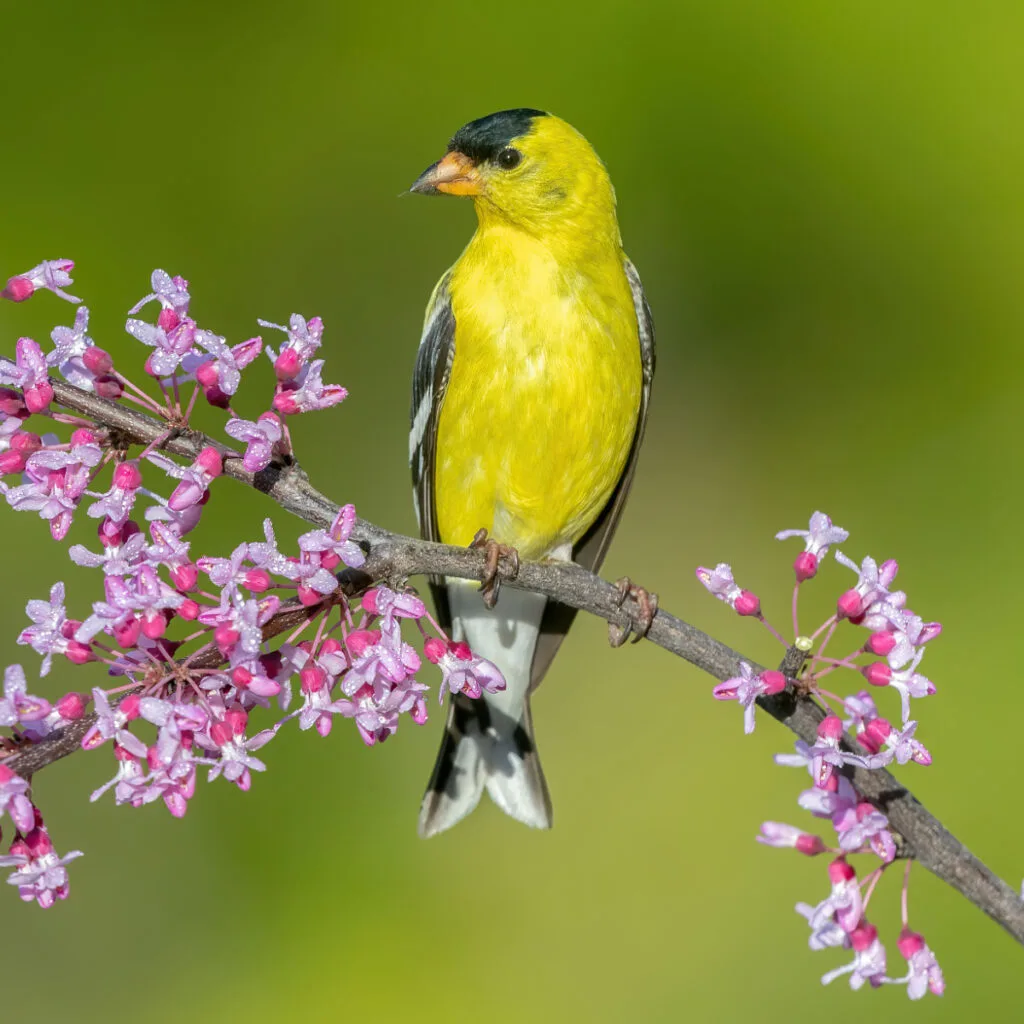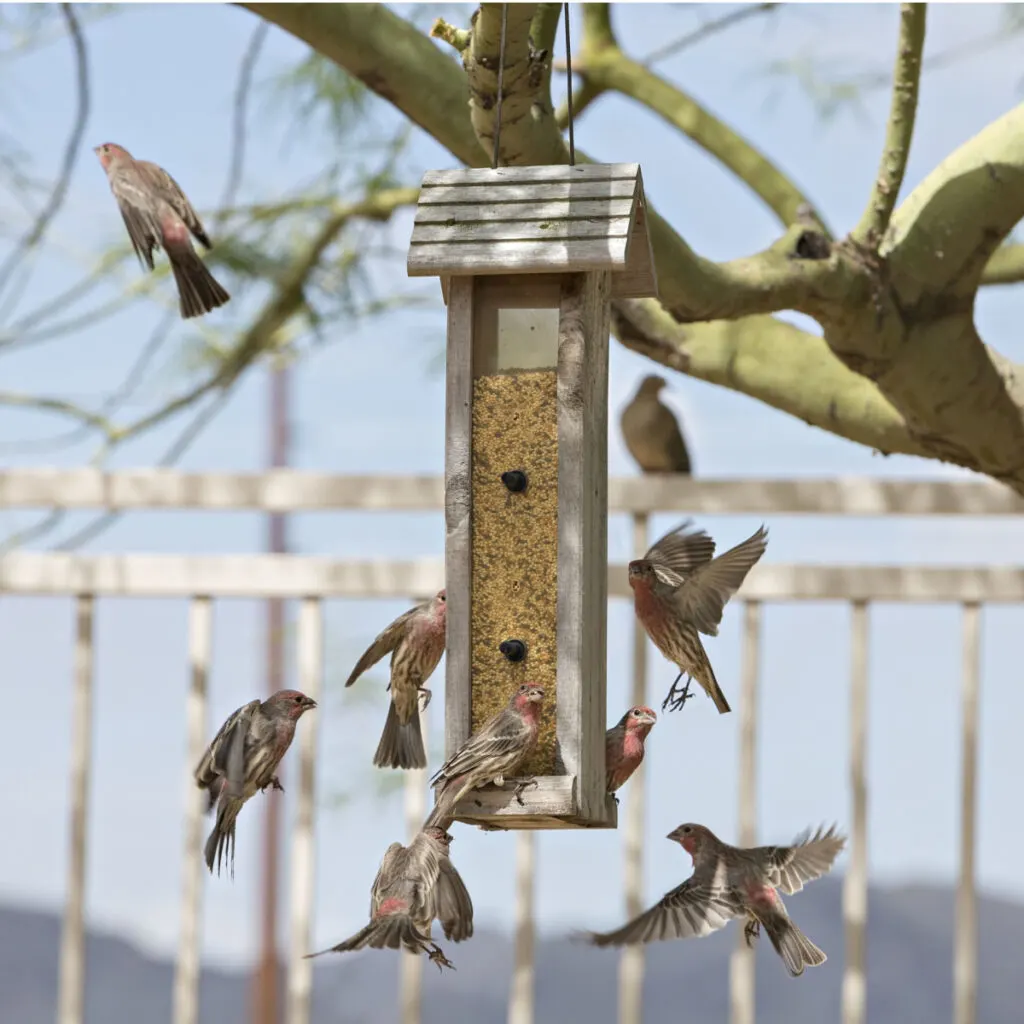Did you know that one of the best ways you can help finches in your backyard stay healthy and alive is to feed them in the winter?
Finches are truly an amazing breed of birds. Especially when you consider all of the different varieties of finches that exist. There are actually over 15 types – including the house finch, the American goldfinch, the purple finch, and even the desert finch, which as its name implies – tends to favor more arid conditions.
Between all of the varieties, finches combine to live in a vast range of climates and regions. And although all finches share the same small to mid-size body type and similar beaks – they have some amazing differences between the varieties that can make them nothing short of fascinating to watch!

For instance, American Goldfinches, whose male species are bright yellow in the spring, summer and early fall, molt from their brightly colored feathers before winter arrives to a very dull brown. Even the females, who are not as brightly colored in the warm months fade to a dull brown as well.
Why? All in an effort to keep safe from eagles and hawks in the barren winter landscape. After all, in a landscape void of foliage and color – those yellow feathers make for an easy target!
Helping Finches Through Winter – How To Feed Finches
But finches have more issues in the winter than simply avoiding eagles and hawks. As primarily a vegetarian bird, they can also go hungry quite quickly. Especially for varieties that do not migrate to warmer climates and are faced with little to no vegetation through the cold months.
Although some species of finches migrate, many others do not. And even those that do head to warmer pastures don’t often fly far. In fact, in nearly all climates and regions, there is at least one variety of finch that stays through the winter.

The house finch, the most common of all finches, tend to shelter in place all winter long – no matter where they live. Because of that, they often find themselves looking for food to help them simply survive.
In the spring, summer and fall, finches burn a lot of energy foraging for their food. With abundant nuts, fruit and seeds available, they rarely have an issue. But through the winter months, they can burn just as much energy simply trying to stay warm – and even more locating scarce food sources to keep them healthy.
That is exactly where a well placed and well stocked bird feeder can save the day! With great winter finch feeding in mind – here is a look at how to do both!
How To Feed Finches In The Winter
Choosing The Right Feeder & The Right Location
Feeding finches successfully all comes down to providing them with highly nutritious food in a safe environment. We will cover the best seeds and feeds in a moment, but let’s start with what type of feeder is best – and where to locate it!

How and where you feed your finches can be just as important as what you feed them. For starters, finches love to feed from tube or sock feeders. Both suspend food and allow the birds to perch and pull out the seeds and nuts they love. Affiliate Link: Kingsyard Metal Finch Bird Feeders
In addition, it’s important to keep your finch feeders clean. Finches will avoid dirty feeders or feeders with mold or moisture, or with seeds that have become soggy or dirty.
In addition to being a bit picky about the type of feeders and feed, finches are also extremely cautious as they eat. Especially in the winter, when there is little natural cover to protect them from prey. Because of this, locating their feeder in a safe location is important.
In the winter, finches will nest as close to a food source as possible. By locating feeders near shrubs, trees and bushes, they can both have a place to nest and cover to eat safely.
By placing feeders near trees and bushes, it does unfortunately increase the chance of squirrels getting to feeders, so protecting the feeders with a squirrel baffle can help alleviate the issue. Affiliate Link : Ansionsol 19 Inch Wide Squirrel Baffle for Bird Feeder Pole

The Food Finches Need & Love – How To Feed Finches In The Winter
So what do finches like to eat? Finches are actually highly vegetarian. In fact, it’s estimated that the house finch consumes over 95% of it’s dietary needs in seeds, fruits and nuts!
Their two favorite foods of all are nyjer (thistle seed) and sunflower seeds. Thistle seed is tiny, and they can easily pull it from feeders. Although you can feed finches whole sunflower seeds, the heart or meaty kernel is what they are after – and if you mix sunflower kernels with thistle seeds – you will have finches feeding happily! Affiliate Link : Finch Blend Bird Food, Mix of Sunflower Hearts & Nyjer Seed
In addition to providing them with seeds, finches also love suet. Suet is fat that has been melted down and often has seeds and other food within it. Hanging a suet block near a finch feeder is truly the perfect combination for feeding finches. See: How To Make Homemade Suet
Together, the high calories and fat content of the seeds and suet provides them with all the energy they need to take on the toughest of winters!

Last but not least, providing your finches with a source of winter hydration is extremely helpful. Water can be hard to come by in the winter. But by setting a small saucer of water nearby and changing it regularly, your finches can stay hydrated with ease.
Here is to feeding the finches in your backyard this winter – and keeping them happy and healthy until next spring!
Follow Our Facebook Page For Even More Great Tips! Simple Garden Life Facebook Page
Simple Garden Life is a website dedicated to keeping gardening fun, simple and enjoyable! We publish two new articles each week along with a new garden podcast episode every two weeks. This article may contain affiliate links.
